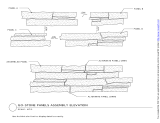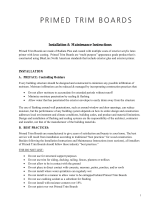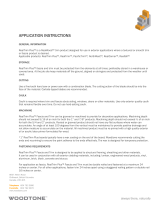
IMPORTANT: FAILURE TO FOLLOW JAMES HARDIE WRITTEN INSTALLATION INSTRUCTIONS AND COMPLY WITH APPLICABLE BUILDING CODES MAY VIOLATE LOCAL LAWS, AFFECT
BUILDING ENVELOPE PERFORMANCE AND MAY AFFECT WARRANTY COVERAGE. FAILURE TO COMPLY WITH ALL HEALTH AND SAFETY REGULATIONS WHEN CUTTING AND INSTALLING
THIS PRODUCT MAY RESULT IN PERSONAL INJURY. BEFORE INSTALLATION, CONFIRM YOU ARE USING THE CORRECT HARDIEZONE® PRODUCT INSTRUCTIONS BY VISITING
HARDIEZONE.COM OR CALL 1-866-942-7343 (866-9-HARDIE).
EFFECTIVE JANUARY 2020
Visit jameshardiepros.com for the most recent version.
SMOOTH | CEDARMILL
©
| SELECT SIERRA 8 | STUCCO
COM1220 P1/4 01/20
HardiePanel
®
Vertical Siding
MULTIFAMILY / COMMERCIAL INSTALLATION REQUIREMENTS
1
Water-resistive Barrier and drainage requirements as defined by building code.
2
Water-resistive Barrier as defined by local building code that is manufactured in a manner to enhance drainage; must meet
minimum 90% drainage efficiency when tested in accordance with ASTM E2273 or other recognized national standards.
3
Water-resistive Barrier (WRB) as defined by building code and a
minimum 3/8 in. (10mm) air space between the WRB and
the panel siding (formed by minimum 3/8 in. furring).
Table 1: HardiePanel
®
Vertical Siding
Wall Drainage Requirements
With a Minimum 12-inch Eave Overhang
Without a Minimum 12-inch Eave Overhang
Vertical Joints
formed by:
Board and Batten;
Moderate Contact;
Caulk
Vertical Joints
formed by
Expressed Seam
Joints
Vertical Joints
formed by:
Board and Batten;
Moderate Contact;
Caulk
Vertical Joints
formed by
Expressed Seam
Joints
Exterior Wall Drainage Requirements
Rainscreen (min. 3/8 in. air gap)
3
Building Height
(Stories)
7 story building
6 story building
5 story building
4 story building
3 story building
2 story building
1 story building
7 story building
6 story building
5 story building
4 story building
3 story building
2 story building
1 story building
James Hardie
Panel Products >
30% of Building's
Total Exterior Wall
Covering
James Hardie
Panel Products ≤
30% of Building's
Total Exterior Wall
Covering
Rainscreen (min. 3/8 in. air gap)
3
WRB
1
WRB
1
Drainage Plane (e.g. drainable WRB)
with 90% drainage
efficiency
2
GENERAL REQUIREMENTS:
• Refer to table 1 for multifamily/commercial drainage requirements for James Hardie
®
vertical siding.
• HardiePanel
®
vertical siding can be installed over furring strips (in accordance with local building code requirements). HardiePanel vertical siding can be installed over
braced wood or steel studs, 20 gauge (0.836 mm) minimum to 16 gauge (1.367 mm) maximum, spaced a maximum of 610mm (24 in) o.c
• Consult ESR1844 for fastener schedule as well as additional technical information at www.jameshardiecommercial.com.
• A water-resistive barrier is required in accordance with local building code requirements. The water-resistive barrier must be appropriately installed with penetration
and junction flashing in accordance with local building code requirements. The manufacturer will assume no responsibility for water infiltration.
• Information on installing James Hardie products over non-nailable substrates (ex: gypsum, foam,etc.) can be located in JH Tech Bulletin 19 at www.jamehardie.com
• Do not install James Hardie products such that they may remain in contact with standing water.
• HardiePanel vertical siding may be installed on vertical wall applications only.
• DO NOT use HardiePanel vertical siding in Fascia or Trim applications.
• The designer and/or architect shall take into consideration the coefficient of thermal expansion and moisture movement of the product in their design. These values
can be found in the Technical Bulletin #8 “Expansion Characteristics of James Hardie
®
Siding Products” at www.jameshardiecommercial.com.
• James Hardie Building Products provides installation /wind load information for buildings with a maximum mean roof height of 85 feet. For information on installations
above 60 feet, please contact JH technical support.
• Minimum standard panel design size is 12" x 16". Note:Panels may be notched and cut to size to fit between windows,doors, corners, etc.
Store flat and keep dry and covered prior to
installation. Installing siding wet or saturated may
result in shrinkage at butt joints. Carry planks on
edge. Protect edges and corners from breakage.
James Hardie is not responsible for damage caused
by improper storage and
handling of the
product.
OUTDOORS
1. Position cutting station so that airflow blows dust away from the
user and others near the cutting area.
2. Cut using one of the following methods:
a. Best: Circular saw equipped with a HardieBlade
®
saw blade
and attached vacuum dust collection system. Shears
(manual, pneumatic or electric) may also be used, not
recommended for products thicker than 7/16 in.
b. Better: Circular saw equipped with a dust collection feature
(e.g. Roan
®
saw) and a HardieBlade saw blade.
c. Good: Circular saw equipped with a HardieBlade saw blade.
INDOORS
DO NOT grind or cut with a power saw indoors. Cut using shears (manual, pneumatic or
electric) or the score and snap method, not recommended for products thicker than 7/16 in.
- DO NOT dry sweep dust; use wet dust suppression or vacuum to collect dust.
- For maximum dust reduction, James Hardie recommends using the “Best” cutting
practices. Always follow the equipment manufacturer’s instructions for proper operation.
- For best performance when cutting with a circular saw, James Hardie recommends
using HardieBlade
®
saw blades.
- Go to jameshardiepros.com for additional cutting and dust control recommendations.
CUTTING INSTRUCTIONS
STORAGE & HANDLING:
IMPORTANT: The Occupational Safety and Health Administration (OSHA) regulates workplace exposure to silica dust. For construction sites, OSHA has deemed
that cutting fiber cement with a circular saw having a blade diameter less than 8 inches and connected to a commercially available dust collection system per
manufacturer’s instructions results in exposures below the OSHA Permissible Exposure Limit (PEL) for respirable crystalline silica, without the need for additional
respiratory protection.
If you are unsure about how to comply with OSHA silica dust regulations, consult a qualified industrial hygienist or safety professional, or contact your James
Hardie technical sales representative for assistance. James Hardie makes no representation or warranty that adopting a particular cutting practice will assure
your compliance with OSHA rules or other applicable laws and safety requirements.











